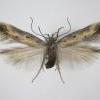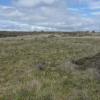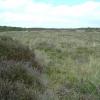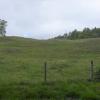35.086 Athrips tetrapunctella (Thunberg, 1794)
Status and Distribution
Scarce, with recent records only known from the Scottish Highlands and western Ireland.
Formerly also found locally in the fenland districts of East Anglia where it was last recorded in 1949 and may now be extinct.
Elsewhere in England, details of records from Kent are unknown, in Surrey a single 19th century record exists, in Hampshire one is noted from Southampton (date not specified) in Goater, B., 1974 (Butterflies and Moths of Hamphire and the Isle of Wight) and there is an unconfirmed historic record from Cheshire.
Provisional map
Foodplant and Larval Feeding Signs
Lathyrus palustris (marsh pea), see plant distribution map, in East Anglia and Lathyrus linifolius (bitter-vetch) and Vicia cracca (tufted-vetch) in Scotland. The larval food-plant/s associated with moth in Cheshire, Kent and Surrey are unknown. In western Ireland Marsh Pea is absent from that area, but the other two do occur (Ken Bond pers. comm.).
Feeds from within a silk tube on the terminal leaves which are roughly spun together.
Habitat
There are three distinct geographical and ecological biotypes documented for this species in the British Isles.
In Scotland, on semi-sheltered and sunny slopes which are either predominantly flowery grassland or grass-heath. They are at low altitude in Highland lower valley sides and often occur alongside Xystophora pulveratella (thanks to Dr. M. R. Young for these details).
In eastern England, at locations where it has been bred, it was associated with the habitat of Lathyrus palustris (marsh pea) - base-rich fens, reed-beds and fen-meadows.
In Ireland it occurs in limestone areas. One site is fenland with reedbeds, while another is in limestone outcrops on the lakeshore, with a rich flora, largely calcareous. The Burren sites are from limestone pavement and calcicole flora, and at least one is close to a lake. Thanks to Ken Bond for the habitat details relating to the Irish records.
Finding the Moth
Larva: feeds from within a silken tunnel in amongst spun terminal leaves.
Adult: can be swept from the foodplant, flies at dawn and dusk and is attracted to light.
Similar Species
In the British Isles the distinctive combination of the angled creamy orange-coloured central streak and series of three black dots are unlikely to be confused with any other species.
In Europe A. nigricostella is very similar but is slightly smaller, has a more pointed forewing and the arrangement of the black spots on the forewing differ. It also utilises a different foodplant, Medicago sativa (lucerne). If this species is ever supected a voucher specimen is essential.
Single-brooded from mid-May to early July. The record from Wiltshire has been found to be erroneous and the dot will be removed in the next map update.
Earliest: 14th May 1998 (VC96).
Latest: 6th July 1963 (VC95).




